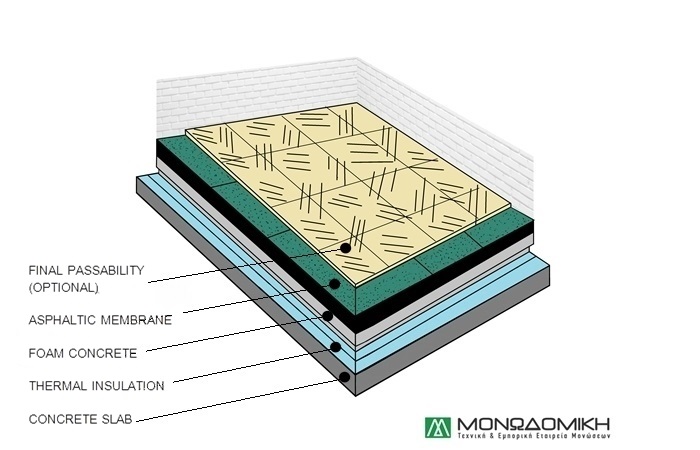
Conventional roof insulation: In this type of construction, we place thermal insulation under the waterproofing. It is recommended for cases where it is not necessary to place a final coating of insulation (tiles), or for lightweight construction need.
In order to understand the significant savings benefit which is achieved by insulating a building (roof and walls), in houses with thermal insulation and especially in new buildings constructed according to the KENAK (Energy Efficiency Regulation for Buildings) specifications, less than 3-5 liters of heating oil per square metre per year is required, while older and uninsulated buildings require 25 liters on average. Some buildings even need 60 liters per square metre per year.
Our company proposes certified systems based on ELOT (Hellenic Organization for Standardization) for the thermal insulation of your roof depending on the use of the surface, the weight of the construction and the cost you are able to spend.
What the specific insulation offers:
It offers you complete protection, winter and summer, from heat, cold and moisture.
What this particular insulation includes:
It includes all the materials of the construction stages of complete roof insulation (tars, polystyrene, cements, asphaltic membrane, sealants) and their implementation by our company's specialized crews.
Stages of construction:
Surface preparation and creation of a vapour barrier.
Preparation of the surface, barrier and the formation of a vapour barrier. After cleaning, the surface of the slab is coated with an asphalt emulsion.
Thermal insulation
Since the most important criterion for choosing thermal insulation material on a roof, apart from its thermal performance, is high resistance to compression, it is recommended to install extruded polystyrene or EPS 150.
Creation of flows
1. Calculation of slopes and placement of filling guides (stitches).
2. Laying of foam concrete (cellular concrete) which is produced on the construction site on a self-propelled unit by a qualified crew, weighing 350-400 kg/m³ to create flows.
Waterproofing
1. Coating the surface with bituminous varnish.
2. Creation of special pieces of asphalt membrane and placing them at a depth of approximately 5-7 cm into the gutters.
3. Gluing additional pieces of asphalt membrane to the vertical elements of the roof and gluing the asphalt membrane in such a way as to facilitate unobstructed water runoff.
Advantages of the system:
Infrastructure requirements:
implementation and material costs start from: 30, 00 €/m2
The cost is directly related to the area of the surface, the quality of the substrate and the degree or level of its preparation.